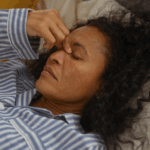Hot flashes. Mood swings. Night sweats. When people think of menopause, these are the usual symptoms that come to mind. But for many women, especially in midlife, a surprising and often overlooked symptom takes center stage: migraines.
As estrogen levels start to shift during perimenopause, the years leading up to menopause, some women experience new-onset migraines, while others see their longstanding migraines become more intense or frequent. These headaches are more than just a nuisance; they can disrupt daily life, affect mood, impair productivity, and lead to medical gaslighting, especially for Black women.1
Understanding this hormonal connection isn’t just helpful, it’s empowering. By recognizing migraines as part of the broader story of menopause, we can advocate for better care and more informed choices.
What Happens During Menopause?
Menopause marks the permanent end of menstruation, typically occurring between ages 45 and 55. But the transition, known as perimenopause, can start years earlier and come with fluctuating levels of estrogen and progesterone—two hormones that regulate not only reproduction but also mood, sleep, temperature, and pain processing.1
These hormones don’t decline in a straight line, they rise and fall in unpredictable waves. And each shift affects the brain, especially the pathways that regulate pain and sensitivity.1
The Hormone-Migraine Link
Estrogen directly influences serotonin, a neurotransmitter that plays a key role in pain signaling. When estrogen levels drop sharply, whether during ovulation, before a period, or in perimenopause, serotonin levels also dip. This neurochemical change can set off migraines.2
That’s why many people experience menstrual migraines, and why those migraines may worsen or emerge in midlife. Hormone-related migraines are usually more intense, last longer, and are harder to treat with over-the-counter pain relievers. These migraines may also come with additional symptoms:2
- Throbbing pain on one or both sides of the head
- Nausea or vomiting
- Sensitivity to light, sound, or smells
- Visual disturbances (auras) before the headache begins
If this sounds familiar and you’re in your 40s or 50s, menopause may be part of the story.
Why This Matters for Black Women
For Black women, menopause and migraines are often under-discussed and under-treated. Studies show that Black women are more likely to:3
- Have their pain dismissed or downplayed by healthcare providers
- Receive inadequate treatment for migraines compared to white patients
- Experience more severe perimenopausal symptoms, including sleep disruption and mood changes
Yet culturally, there’s often stigma around aging and vulnerability. Many Black women have been socialized to “push through” pain, to care for others first, and to minimize their own symptoms. This culture of endurance, while rooted in resilience, can delay diagnosis and prevent access to effective treatments.3
Compounding the issue is the racial gap in migraine research and menopause care. Most studies on hormonal migraine management have focused on white women, leaving significant gaps in how treatment protocols apply to Black patients.3
We must shift this narrative. Talking openly about menopause and migraines in trusted spaces like the NOWINCLUDED community helps normalize these conversations and demand care that reflects our realities. You deserve to be heard, believed, and treated, without delay or dismissal.
How to Manage Menopause-Linked Migraines
If you suspect that your migraines are connected to hormonal changes, you’re not imagining things, and you have options.
Medical Approaches:
- Hormone Replacement Therapy (HRT): Stabilizes estrogen levels, though it may not be appropriate for everyone (especially those with heart risks or hormone-sensitive conditions).4
- Migraine-specific medications: Triptans are commonly used to stop migraines once they start. For frequent migraines, your doctor may prescribe preventatives like CGRP inhibitors, beta-blockers, or anticonvulsants.4
Lifestyle Adjustments:
- Sleep: Stick to a consistent sleep routine; irregular sleep can be a migraine trigger.5
- Hydration and Nutrition: Avoid skipping meals, reduce processed foods, and increase magnesium-rich foods (like leafy greens, beans, and nuts).5
- Stress Management: Stress is a major migraine trigger. Incorporate daily mindfulness, deep breathing, or restorative movement like yoga.5
- Avoid known triggers: For some, alcohol, caffeine, or certain foods (aged cheese, processed meats) may worsen migraines.5
When to Seek Medical Help
If your headaches are happening more frequently, last longer or feel more severe than usual or include neurological symptoms like vision loss, speech difficulty, or numbness, it’s time to see a healthcare provider.6 Bring a detailed symptom journal noting:
- Time of day and frequency
- Triggers (e.g., stress, food, sleep disruption)
- Relationship to your menstrual cycle
- What treatments you’ve tried and how they’ve worked
This helps your clinician differentiate between perimenopausal migraine, other headache types, and possible underlying conditions.
Final Takeaway
Menopause is a profound transition, physically, emotionally, and neurologically. Migraines may be an unexpected part of that journey, but they don’t have to be a mystery or a burden you bear alone.
Knowledge is your power. When we understand how hormone shifts impact our health, we can demand better care, make informed choices, and support each other through midlife and beyond.
So, if your head is pounding and you’re in your 40s or 50s, don’t brush it off. It might just be menopause talking.
References
- American Migraine Foundation. (2022, October 6). Migraine and Menopause. Retrieved from American Migraine Foundation: https://americanmigrainefoundation.org/resource-library/migraine-and-menopause/
- Watson, S. (2024, April 23). Migraines and Menopause. Retrieved from WebMD: https://www.webmd.com/migraines-headaches/migraines-menopause
- Bass, L. (2023, May 5). Are Vasomotor Symptoms More Severe in Black Women? Retrieved from Healthline: https://www.healthline.com/health/menopause/black-women-severe-vasomotor-symptoms
- Pavlović, J. M. (2019). Evaluation and management of migraine in midlife women. Menopause. doi: 10.1097/GME.0000000000001104
- American Migraine Foundation. (2016, April 12). Headache Hygiene – What is It? Retrieved from American Migraine Foundation: https://americanmigrainefoundation.org/resource-library/what-is-headache-hygiene/
- Cherney, K. (2024, May 30). When Should You Go to the ER for Migraine? Retrieved from Healthline: https://www.healthline.com/health/migraine/er-for-a-migraine









